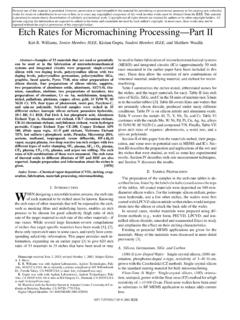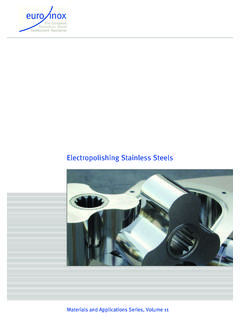Transcription of Corrosion handbook - Hilti
1 Corrosion handbookMay 2015 Corrosion handbookpage 2 Corrosion handbookForewordCorrosion is a ubiquitous natural process. Most of us, at some point in our everyday lives, become familiar with the effect that Corrosion has on rusted steel parts. Corrosion has a huge economic impact. About a fifth of the world s annual steel production goes towards simply replacing steel parts damaged by Corrosion . Even though it may involve higher up-front cost, correct and efficient Corrosion protection at the source helps save money and resources in the long run. For fastening systems, it s even more critical as safety is key. Failure due to Corrosion may have dramatic goal of this brochure is to raise your general awareness of what Corrosion is all about. It provides you with basic information on Corrosion and the behavior of the materials used to protect our products from conducts comprehensive laboratory and field-based tests to assess the Corrosion resistance of its products.
2 Some long-term tests started in the 1980s are still running today. Thanks to in-house research and close collaboration with renowned universities and laboratories, Hilti is in a position to offer the right solutions with the most suitable Corrosion protection for a wide variety of environmental , the choice of the material or the Corrosion protection method for a specific application remains the responsibility of the user. Your local Hilti contact will be pleased to provide further assistance. He or she will also be able to obtain support at any time from the specialists in our Corporate Research & Technology department, allowing you to take advantage of the wealth of in-depth know-how they have handbookCorrosion handbook page 3 ContentForeword 21.
3 Basics of Corrosion What is Corrosion ? Forms of Corrosion Uniform Corrosion / shallow pitting Corrosion Pitting Corrosion Crevice Corrosion Environmental induced cracking Intercrystalline (intergranular) Corrosion Galvanic (contact) Corrosion 132. Hilti Corrosion performance assessment and product qualification methods Purpose of Corrosion testing Lab facilities/tests Outdoor field tests 183. Hilti Corrosion protection solutions Corrosion and Corrosion protection of carbon steel Corrosion behavior of stainless steel Preventing of galvanic Corrosion 294. How to assess Corrosion in an specific environment/application Factors influencing atmospheric Corrosion Assessment of corrosivity for zinc coated products Assessment of corrosivity for stainless steel products 365. How to select a suitable fastener and installation system Selecting the right Corrosion protection for anchors, powder-actuated fasteners and screws Selecting the right Corrosion protection for wood nails Selecting the right installation system 446.
4 Bibliography 457. Disclaimer 47 Corrosion handbookpage 4 Corrosion handbookCorrosion handbookCorrosion handbook page 51. Basics of Corrosion What is Corrosion ? Corrosion is the physicochemical interaction between a metal and its environment, which results in changes in the metal s properties and which may lead to significant functional impairment of the metal, the environment, or the technical system of which they form a part (see ISO 8044:2010).We only talk about Corrosion when there is a change in the metal s or system s properties which may lead to an undesirable outcome. This can range simply from visual impairment to complete failure of technical systems that cause great eco-nomic damage and even present a hazard to the metals commonly used in engineering, such as carbon steel, stainless steel, zinc, copper and aluminium, the typical Corrosion process can be regarded as the thermodynamically favored reverse reaction of the metal-winning (extraction) process (see Fig.)
5 1).metal winning requires energyFe2O32 Fe + 3/2 O2low-energy state (stable) Corrosion reactionhigh-energy state (unstable)Fig. 1: Chemical reactions of iron during Corrosion and the metal-winning process. Types of Corrosion reactionsLike all chemical reactions, Corrosion processes take place when conditions are in favor of the related chemical reactions (thermodynamics). Then, potential other factors drive the speed of the reaction (kinetics). We will make a distinction between the types of Corrosion , generally describing the interaction between the metal and the environment, and forms of Corrosion describing the phenomenological reactionA typical chemical Corrosion reaction occurs at high temperatures, where the metal reacts with hot gases and forms an oxide layer. Metallophysical reactionAn example of this is the embrittlement caused by hydrogen which diffuses into a metal, possibly leading to failure of a component.
6 Embrittlement can be the result of a careless manufacturing process, when surface coatings such as electro-chemical zinc plating are not applied properly on high-strength steel products (primary embrittlement). It can also be initiated by Corrosion processes (metal dissolution). In the latter case, reference is made to Corrosion -induced hydrogen assisted cracking (secondary embrittlement).Electrochemical reaction (most frequent type of Corrosion )The most common Corrosion reaction is electrochemical in nature. Such reactions imply an electrical exchange by way of electrons in the metal and ions in a conduct-ing electrolyte, such as a water film on its handbookpage 6 Corrosion handbookThe overall reaction can be separated in two partial reactions: Metal dissolution, also known as oxidation or anodic Fe -> Fe2+ + 2 e- Reduction or cathodic reaction, a reaction mainly involving the oxygen present in the air with water O2 + 2 H2O + 4 e- -> 4 OH-These two partial reactions can take place on the metal surface in a fairly homoge-nous distribution leading to uniform attack (see section ) or can occur locally and separately, leading to localized forms of Corrosion such as pitting mechanism and the electrochemical nature of the Corrosion reaction define the necessary requirements for Corrosion to take place.
7 A conducting metal an electrolyte (a thin moisture film on the surface is already sufficient) oxygen for the cathodic reaction(OHFWURO\WHZDWHU2[\JHQ0 HWDO&RUURVLRQFig. 2: Requirements for the atmos pheric Corrosion reaction. The illustration in Fig. 2 shows the basic Corrosion mechanism of iron under a drop of water. Both metal dissolution and oxygen reduction reactions take place with slight separation on the surface, and their products (Fe-ions and OH-ions) react in the water drop to form red general, the same scheme applies to other metals such as zinc or aluminium but with slightly different chemical reactions in the the simple model of the Corrosion reaction, as seen in Fig. 3, we are able to explain many forms of Corrosion and also to deduct measures to mitigate Corrosion . By preventing or slowing down one of the partial reactions, the overall Corrosion rate is also reduced.)]
8 Fig. 3: Corrosion of iron under a drop of water, showing metal dissolution, oxy-gen reduction and the formation of H H )H 2 2+2+2 H Corrosion handbookCorrosion handbook page Forms of Uniform Corrosion / shallow pitting corrosionUniform Corrosion is a form of Corrosion where the surface is removed almost evenly. The partial reactions (metal dissolution and oxygen reduction) are statistically distributed over the surface, leading to more or less homogenous dissolution of the metal and uniform formation of Corrosion products ( red rust on steel).The extent of this form of Corrosion can usually be well estimated on the basis of previous experience. The rate of Corrosion is usually given in micrometers per year ( m/a). Using these average values, it is possible to calculate the life expectancy of a component, and thus to enhance its life expectancy by increasing its thickness.
9 Uniform Corrosion takes place, for example, on unprotected carbon steel and on zinc-coated steel under atmospheric reality, purely homogenous Corrosion attack is unlikely to take place. There are always areas, especially on complex metal parts, which will corrode faster than others leading to a more or less rough surface with an irregular covering of corro-sion products (see Fig. 4).Fig. 4: Corrosion of steel QREOH/HVV QREOHC orrosion handbookpage 8 Corrosion Pitting corrosionPitting Corrosion is a localized form of Corrosion that leads to the creation of small holes or pits in the metal (see Fig. 5). This form of Corrosion is mainly found on passive metals. Passive metals and alloys, such as aluminium, titanium and stainless steel owe their Corrosion resistance to a thin oxide layer on the surface with a thickness of only a few nanometers.
10 The Corrosion initiating process starts with a local break-down of the passive layer. Local corrosive attack can be initiated on stainless steels, for example, by chloride 6 shows the most significant phases of this Corrosion phenomenon on stainless steel. Pitting Corrosion can be quite problematic. Whereas uniform Corrosion can be seen clearly on the surface, pitting Corrosion often appears only as small pinholes on the surface. The amount of material removed below the pinholes is generally unknown, as hidden cavities may form, making pitting Corrosion more difficult to detect and predict. Technically, there is no reasonable way to control pitting Corrosion . This form of Corrosion must be excluded right from the start through design considerations and use of the right addition, pitting Corrosion can often be the starting point for more severe forms of Corrosion such as stress Corrosion cracking (see section Stress Corrosion cracking (SCC) ).

